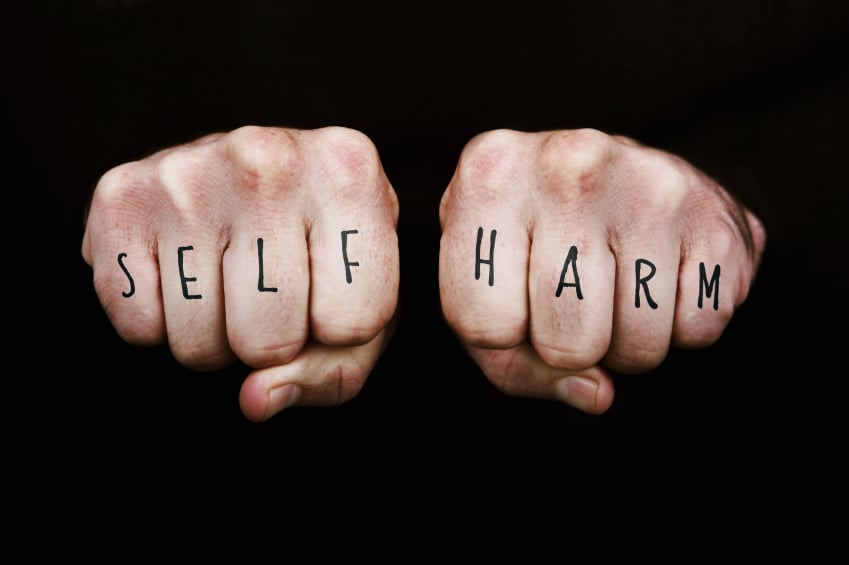Self-Harm: What It Is, The Reasons Behind It, and Myths That Surround It.
by Ellen R. Eggerding, MA, LLPC
What comes to your mind when you hear the words “Self-Harm”? Is it fear? Is it doubt? How about angst, despair or horror? There are many different reactions to the words “self-harm.” There are also many reactions to the people who engage in the behavior, and most of these reactions are hurtful and can actually reinforce the behavior of self-harm. I am writing this blog to open the dialog around self-harm, expose some of the reasons behind the behavior and dispel some of the common myths surrounding it. My goal is to reduce the stigma surrounding the behavior and perhaps assist us all becoming more helpful and supportive to those who engage in the desperate behavior of self-harm.
The information I share here is gathered through research of books, TED Talks, seminars, and an actual client of mine. She will stay anonymous, but I asked her if I could share some of her story in this blog, and she graciously agreed. I want to start with what “self-harm” actually is so that your knowledge can grow around the subject, but also so that there is a clear understanding with what I am discussing in this blog. There are 3 types of “self-mutilation,” each having its own roots and motivations. The first is Major self-mutilation. This includes drastic acts of self-injury to include self-castration, amputation of a limb, or the removal of an eye. These acts are most often the result of psychosis or acute intoxication and often have religious or sexual undertones. The second type of self-mutilation is Stereotypic Self-Injury, which includes head banging, biting, and skin scratching. These rhythmic and monotonously repetitive behaviors are commonly associated with organic brain disease such as intellectual disability, autism and Tourette’s syndrome. The third type of self-injury is called Moderate/Superficial Self-Mutilation, (self-harm) and this is what I am referring to in this blog.
People participating in self-harm use a variety of sharp instruments to carefully make controlled and relatively shallow cuts in their skin. Some people engage in this only episodically, whereas others engage in it repetitively, and may take on an identity as a “cutter.” People who self-harm frequently are often preoccupied by thoughts of cutting and feel addicted to the behavior. This is how my client reports feeling. There are three subtypes of this type of self-harm: episodic, repetitive, and compulsive. Cutting, burning and bone-breaking can be either episodic or repetitive. People who self-harm both episodically and repetitively hurt themselves for the same reasons: to relieve tension, release anger, regain a sense of self-control, and/or terminate states of emotional deadness. Many individuals who self-harm report difficult and traumatic childhoods with the majority reporting emotional, physical or sexual abuse. They most commonly describe themselves as feeling empty inside, unable to express emotions in words, afraid of getting close to anyone, and wanting to desperately stop their emotional pain. Participating in self-harm gives them a sense of relieving tension, releasing anger, regaining a sense of control and terminating states of emotional deadness.
Many individuals who self-harm employ depersonalization, which is when a person’s thoughts and feelings seem unreal or not to belong to oneself, or in which one loses all sense of identity, as a coping technique in order to escape pain. Depersonalization is equal to feeling like you are no longer going to exist. Self-harm provides a sense of reintegration for them, like a jolt of reality to the vanishing self. The sensation of pain and the sight of blood break through the deadening depersonalization and prove that the cutter is alive, human, and whole. Individuals who self-harm have reported, “With the pain, cutting and burning bring me back into sharp focus. I am in control again” and “cutting substitutes the pain inside with a physical pain that I can control, which is easier to handle. The pain is now real, tangible. It can be seen.”
Some of the most common myths about self-harm are just not true. One such myth is that self-harm is just attention-seeking. For some, self-harm is clearly an attention-seeking act, and in this case, it is very important to recognize this and honor the intent. The person is crying out for help. However, the majority of people who self-harm go to great extremes to hide their cuts, scars or burns. Another myth is that self-harm is a suicide attempt or a failed suicide attempt. Most individuals who self-harm engage in the behavior as a means of avoiding suicide. The third myth is the belief that “there is nothing I can do to help.” There are many ways you can help. The first, and most important, is to just listen. Don’t judge and be as supportive and understanding as you can. The way you can help can really be summed up in this simple phrase: don’t give up on them.
If you would like to learn more about self-harm, the reasons behind it, and ways to help, I would recommend the following resources:
“A Bright Red Scream: Self-Mutilation and the Language of Pain” by Marilee Strong.
“Top 15 Misconceptions of Self-Injury” by Saskya Caicedo and Janis Whitlock https://www.researchgate.net/publication/236831665_Top_15_misconceptions_of_self-injury/link/02e7e5193e85b220c6000000/download
“Suicide and Psychological Pain: Prevention That Works” by Jack Klott



2 Responses
Your articles never fail to captivate me. Each one is a testament to your expertise and dedication to your craft. Thank you for sharing your wisdom with the world.
Your words feel alive, vibrant yet calm. They carry energy without agitation, leaving the reader both engaged and serene.